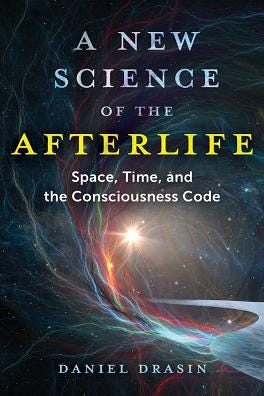Exploring Scientific Insights into the Afterlife Phenomenon
Written on
Chapter 1: The Nature of Consciousness and the Afterlife
Daniel Drasin presents a thought-provoking analogy: "If consciousness resembles an infinite ocean, then a soul could be visualized as a wave that persists over time." With over three decades dedicated to studying the afterlife and paranormal events, Drasin meticulously examines the evidence supporting the notion that human consciousness may endure beyond physical existence. He advocates for a serious scientific exploration of a "Greater Reality."
In his recent publication, A New Science of the Afterlife: Space, Time, and the Consciousness Code (Park Street Press, June 2023), which spans just 110 pages, Drasin delivers an engaging and straightforward analysis of contemporary scientific findings in this domain. The book not only compiles valuable resources but also offers insightful reading recommendations, making it a compelling read that I completed in one sitting.
Drasin encourages readers to embark on "a profound journey into one of today's most intriguing realms of scientific inquiry," discussing fifteen promising avenues of research that challenge traditional materialist views. He humbly notes that his work is merely a small part of the growing body of literature exploring science-based perspectives on the afterlife.
In a world largely influenced by materialism—a perspective that is, at best, a mere assumption about reality—Drasin's approach fosters a refreshing, consciousness-centered view. This perspective is essential for achieving a deeper understanding of fundamental concepts such as consciousness, space, time, life, and death.
Despite social pressures and pervasive skepticism that often stifle post-materialist investigation, Drasin remains optimistic about a potential paradigm shift. He believes it is possible to objectively demonstrate the persistence of consciousness beyond the physical body, a shift that would necessitate a reevaluation of conventional scientific paradigms.
Drasin is an award-winning documentary filmmaker and has explored afterlife communication through various mediums, including traditional mental and physical mediumship and modern electronic methods. His documentary Calling Earth highlights his active engagement in this field since the early 1990s. Now in his eighties, Drasin has spent over sixty years as a photographer and media producer, residing in the San Francisco Bay area.
If Drasin's findings hold true, he suggests that the existence of a Greater Reality becomes undeniable: a realm where our awareness and sense of self exist between our physical lives, potentially embedding our entire universe. He aims to help readers recognize, understand, appreciate, and connect with this Greater Reality while still engaging meaningfully with the physical world. The increasing evidence supporting its existence challenges established academic, scientific, and cultural institutions.

Section 1.1: Rigorous Academic Research
Drasin argues that sufficient evidence for an afterlife has always existed for believers, yet skeptics remain unconvinced. He points to groundbreaking advances in psychic and electronic communication with the "other side," as well as rigorous academic investigations into reincarnation, mediumship, and terminal lucidity. These developments are compelling the question of an afterlife into more open discourse.
He highlights three pivotal areas providing strong evidence for the survival of consciousness: electronic communication methods capturing voices and images of the deceased, the five-year Scole Experiment in physical mediumship conducted in the late 1990s in Norfolk, UK, and the remarkable case of Californian toddler James Leininger, who reportedly recalled being James McReady Huston Jr., a WWII pilot.
Interestingly, as early as 1985, the philosopher Colin Wilson noted the "impressive inner consistency of the evidence" pointing towards survival in his influential book Afterlife: An Investigation of the Evidence for Life After Death. Wilson urged that no one should feel embarrassed to accept the concept of survival after death. Nearly four decades later, as Drasin's work suggests, the evidence has only strengthened. Wilson believed that humanity is "intended to be the masters of time, not its slaves."
Section 1.2: Understanding the Consciousness Code
Drasin posits that consciousness manifests as "an irreducible field" with remarkable attributes, such as the capacity for experience, intention, and purpose. He argues for a new terminology to describe this phenomenon, suggesting it is richer and more complex than our conventional understanding of consciousness.
So, what is this Consciousness Code? Drasin explains that a code can be something whose significance or existence remains partially concealed; thus, consciousness exemplifies a code "hiding in plain sight." He asserts that recognizing this code allows us to navigate life and death in a more enriching and profound manner. While we often associate consciousness with the workings of the brain, Drasin argues that the brain is merely a receiver, not equivalent to consciousness itself.
Yet, how can we unravel this code in a culture heavily influenced by materialism? Drasin acknowledges the difficulty in decoding its extraordinary nature and potential. However, he emphasizes that language shapes our perceptions of life and death, offering thought experiments and exercises designed to challenge materialist ideologies and foster awareness of the Greater Reality.
Awareness of this Greater Reality, which I believe imparts deep meaning and purpose to our lives, is essential and can be nurtured through scientific inquiry. To maintain a belief in the certainty of life after death without such awareness may lead to a detrimental escape from reality, suggesting that uncertainty could sometimes be preferable.
In this thought-provoking video, experts Lisa Miller, Nick Lane, and Paul Bickley discuss whether science can genuinely support the concept of life after death.
This enlightening segment from TODAY explores how science is being utilized to investigate the concept of an afterlife, bringing us closer to understanding this profound mystery.